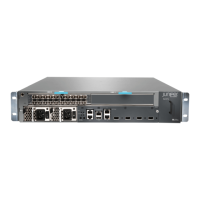5. Slide the transceiver until the connector is seated in the component slot. If you are
unable to fully insert the transceiver, make sure the connector is facing the right way.
6. Close the ejector handle of the transceiver.
7. Remove the rubber safety cap from the transceiver and the end of the cable. Insert
the cable into the transceiver.
WARNING: Do not look directly into a fiber-optic transceiver or into the
ends of fiber-optic cables. Fiber-optic transceivers and fiber-optic cables
connected to a transceiver emit laser light that can damage your eyes.
8. Verify that the status LEDs on the component faceplate indicate that the SFP or XFP
is functioning correctly. For more information about the component LEDs, see the MX
Series Interface Module Reference.
Maintaining Cables That Connect to MX5, MX10, MX40, and MX80 MICs
Purpose For optimum router performance, verify the condition of the cables that connect to the
MICs.
Action On a regular basis:
• Use the cable management bracket to support cables and prevent cables from
dislodging or developing stress points.
• Place excess cable out of the way in the cable management bracket. Do not allow
fastened loops of cable to dangle from the connector or cable management bracket,
because this stresses the cable at the fastening point. Putting fasteners on the loops
helps to maintain their shape.
• Keep the cable connections clean and free of dust and other particles, which can cause
drops in the received power level. Always inspect cables and clean them if necessary
before connecting an interface.
• Label both ends of the cables to identify them.
The following guidelines apply specifically to fiber-optic cables:
• When you unplug a fiber-optic cable, always place a rubber safety plug over the
transceiver on the faceplate and on the end of the cable.
• Anchor fiber-optic cables to avoid stress on the connectors. Be sure to secure fiber-optic
cables so that they do not support their own weight as they hang to the floor. Never
let fiber-optic cable hang free from the connector.
• Avoid bending fiber-optic cable beyond its bend radius. An arc smaller than a few
inches can damage the cable and cause problems that are difficult to diagnose.
113Copyright © 2019, Juniper Networks, Inc.
Chapter 4: Maintaining Components

